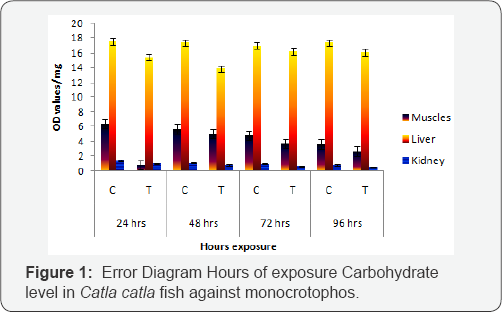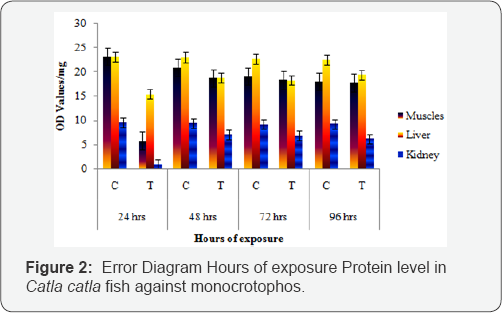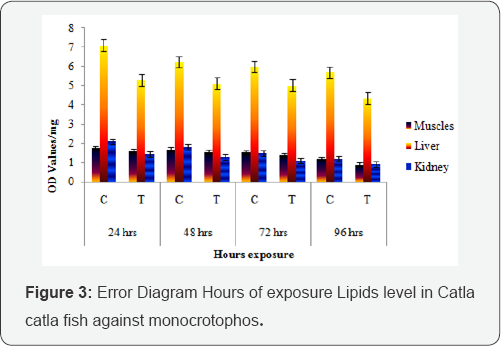The Toxicity Effect of Monocrotophos 36% E.C on the Biochemical Change in Catla Catla (Hamilton, 1882) _ Juniper Publishers
JUNIPER PUBLISHERS-GLOBAL JOURNAL OF PHARMACY & PHARMACEUTICAL SCIENCES
Authored by Pugazhendy K
Abstract
This study was undertaken to find out the Catla catla fresh water fish biochemical changes in the fish muscles, liver and kidney. Toxicity were calculated probit analysis, The total carbohydrate contented was estimated by the technique of Roe , Protein was estimated by Lowry method and total lipids were estimated by the method of floch methods. The results shown on total carbohydrate level in muscle 6.43mg/g after treatment 2.70mg/g, liver carbohydrate control 17.55mg/g after treatment 16.10mg/g changes accrued 7.41% and kidney carbohydrate control 1.44mg/g after treatment 0.53mg/g was gradually decreased. Then total protein in muscles 23.20mg/g after sub lethal concentration at 96hours treated 17.80mg/g decreased and liver protein 23.12mg/g treated fish 19.40mg/g changes accrued 13.58% kidney protein level 9.60mg/g after treatment in sub lethal concentration in 96hours 6.24mg/g were decreased and Total lipid level are in muscles 1.78mg/g after 96hours 0.89mg/g liver lipid 7.10mg/g after treatment 4.35mg/g then kidney 2.09mg/g, 0.92mg/g simultaneous gradually decreased muscles, liver and kidney. The Monocrotophos affects not only fishes but also organisms in the food chain through the procedure of expenditure of one by the other those human begins affected various genetic disorders absolutely insecticides.
Keywords: Monocrotophos; Catla catla; Carbohydrates; Protein; Lipids
Introduction
Pesticides are generally used in contemporary agriculture to aid in the manufacture of high quality food. However, some pesticides have the probable to cause serious environment and health directly or ultimately [1]. Long-term expose function of toxic chemical as well as pesticides in different ecosystems, which due to their high efficacy and easy use have eliminate some biological methods of pest control, was caused by ecological pollution [2]. Developed and developing countries which are succeeding quickly in the field of agriculture, technology and industry are incessantly release a variety of kinds of harmful substance into the biosphere and in this manner cause a brutal hazard to the environment [3,4]. The most important source of irrigate pollution are household, agricultural and industrialized waste which are discharge into ordinary water body [5].
Domestic sewages are sprint decomposed commencement agriculture field weighed down with pesticides and fertilizers contaminate the water body. Frequently worn pesticides can be injurious livelihood organisms, pets, and their surroundings. These dropout frequently enclose an assortment of type of pollutant such as heavy metals, radioactive elements, pesticides, herbicides and sarcastic substance like acids and basis [6] reuse bring into play of pesticides causes element pollution consequences in the near future health hazard to be alive stock, above all to fish, birds, frogs, and mammals all live animals [7].
Rhythmic experience to sub-lethal dose of some pesticides can cause physiological and behavioral, biochemical and histological changes in fish getting directly [8] that reduce populations, such as leaving behind of nests and broods, decreased imperviousness to disease and greater than earlier than failure to let alone predators [9]. Nowadays modern globalization assortments of factor poignant formers are using authenticity of pesticide, insecticide, herbicide using agricultural countryside. The pesticide mainly two types Organochlorine, organophosphate and various types of mechanism like pesticide insecticide in topical year monocrotophos is organophosphate using their field of scheming the creepy-crawly pest. Aquatic water bodies are frequently polluted with a numerous of potentially dangerous substance [10].
Fishes play a very important accountability in human nourishment fish proteins are well balanced with obligatory amino acids and are analogous to other proteins of animals' origin [11]. A supplementary fish contains lipids particularly omega fatty acids from the human nutrious position of inspection, eminent and excellence in attendance in maritime and cultivable fishes. Various toxicity data symbolize for assortment of pesticide such as organophosphate, organochlorine, carbamide and pyrethroid pesticides have been reported for number of fish species noted various approaches and momentous researchers find out like Visvanathan et al. [12], [13-18]. The enzyme activity slowly but surely level of decreases mercury chloride (PbCl3) using pesticide martin [19]. Metabolic activity and physiological activity studies alone do not satisfy the accomplished various toxic pathological circumstances of tissue under toxic stress. The natural physiological accomplishment of an organisms get dispersed on reporting to toxicants, stress, it induces its effect first at cellular or even at molecular level, but ultimately cause physiological, pathological and biochemical modification [20].
The biochemical changes occurrence in the body of the organisms give first indication of stress several investigators have description a quantity of change in biochemical parameter of aquatic organisms due to pesticides reporting [21-25]. Carbohydrates form one of the major source of energy forerunner under any stress circumstance. Total carbohydrate satisfied decreased during the revelation to monocrotophos in the air breathing fish Anabas scandens maximum decrease in the brain tissues observed on 21st day [26]. The total decrease in carbohydrate level has been noted in the liver and muscle of Heteropneustes fossilis showing to Butachlor [27]. Chlorpyrifos, an organophosphate compound diminish hepatic glycogen level due to inactivation of enzymes concerned in the carbohydrate metabolism in the fresh water fishes, such as Catla catla, Labeo rohita and Cirrhinus mrigala [28]. Momentous fall in the entire biochemical constituent in all the tissues except glucose prompt to propose that the fish cultured in the aquatic systems earlier to the industrial locations would not have the predictable nutritive value [29]. Because of their low insistence, frequent application of these pesticides are life form skillful for the have power over of pests in agricultural fields and thereby large quantities find their way into water bodies.
Protein being the essential substance is desirable for growth and enlargement and also serves as energy source during the stress condition. The total protein point of muscle and liver are decreased in freshwater telelost fish, Channa punctatus showing to Nuvacron [30]. Decreasing trends have been reported in gill, liver, muscle and brain tissues of O. mossambicus exposed to Quinalphos [31]. Lipids are in general triglycerides that can dish up as metabolic reserves. Phospholipids show a quick diminish given that it is aggressively degraded due to the pesticide stress [32,33] reported decrease in liver lipid content of Barbus chonchonius exposed to Aldiocarb for 15 and 30days for sublethal concentration.
In general, the end point worn in toxicity studies is mortality, survival and growth with acute toxicity tests, the consideration are quite apposite, but for long-term sub lethal concentration's this applicable parameter are easier said than done to ascertain [34]. Organophosphate (OP) pesticides are pronouncement increasing use in recent years since they are biodegradable therefore keep it up in the environment only for a short time. Therefore, in the present study enhance and accommodating to such as good finding an the assessment of biochemical components like a total carbohydrates, protein and total lipids, in the muscle liver kidney and studies of the fresh water fish in Catla catla. Now day’s farmers are using an assortment of pesticide and insecticide monocrotophos in their grassland of cultivation devious the insect pest. Residual of this pesticide alters in to the ecosystem and trouble the healthy environment and aquatic forms. Aquatic farm contains fish and other organism. But the fish is mostly affected by pesticide residuals.
Experimental
Acclimatization
Healthy freshwater fish Catla catla finger links of the weight (10±1g) and length (8.0±0.5cm) were selected for the experiment and were collected from the local commercially culture farm Kumbakonam near Swamimalai HAQ fish culture pond. Fish were screen for any pathogenic infections. Glass contamination aquaria were washed with 1% KMnO4 to keep away from fungal contamination and then dried in the sun light. In good physical shape fishes were then transfer to glass aquaria (35:20:20cm) containing dechlorinated tap water. Fish were acclimatized to laboratory conditions for 10 to 15days prior to carrying out tests. The rate of humanity during becoming accustomed was less than 10%. They were habitually fed with marketable food. Chlorinated tap water was misrepresented every day to take not here face and foodstuff bits and pieces.
Toxicity test
Toxicity tests were conduct in harmony with customary methods. Accumulation solution of monocrotophos 36% EC with an attentiveness of 0.1ml per liter (equivalent to 1ppm) was prepared in distilled water. Based on the progressive bisection of intermission on a logarithmic scale, log concentrations were fixed after conducting the assortment pronouncement test. The fish were starved for 24hours aforementioned to their use in the experiments as not compulsory by luggage compartment to avoid any intrusion in the toxicity of pesticides by excretory products. After the adding together of the toxicant into the test tank with 10liters of water have twenty fish, mortality was record after 24, 48, 72 and 96hours. Five replicates are maintained concurrently. Percent mortality was premeditated and the morals were transfer into probit scale.
Probit analysis was carried out as recommended by Finney [34]. Deterioration appearances of probit alongside logarithmic transformations of concentrations were made. Off the record limits (upper and lower) of the regression line with chi-square test were calculated by an automated curriculum SPSS Version 14 for Probit analysis.
Total carbohydrate estimation
The total carbohydrate at ease was humdrum by the practice of a 10% homogenate of tissue muscles, liver, kidney was equipped using 5% TCA and this was centrifuged at 3000rpm for 10minutes. Samples were cooled in the dark at space temperature for 30minutes. The supernatant was collect and the optical density was deliberate in a spectrophotometer (Hitachi 2205) at a wavelength of 620nm a blank explanation. Blank was geared up by integration 1ml of distilled water with 4ml of Biuret reagent. The total carbohydrate content was intended in mg/g of tissue.
Total protein estimation
Protein was estimated by the method of 1% tissue homogenate were outfitted in 10% TCA and centrifuged at 3000rpm for 15minutes [35]. The gal set was liquefy in 1ml of 1N NaOH to the higher than 5ml of alkaline copper reagent was added and after 10minutes, 0.5ml of folin phenol reagent was considered after was accompanying and quickly The mugginess content was estimated by subtracting the dry heaviness (dried in hot air oven) recognized wet of the tissue muscles, liver, kidney [36].
Lipid estimation
The total lipids were extract by the method of to find out total lipid, known volume of conduct experiment samples were homogenized with 1ml of methanol and 2ml of chloroform to which again 2ml of chloroform : methanol (2:1v/v) was added and mixed systematically [37]. To this, 0.2ml-0.09% sodium chloride explanation was added. The above mixture was poured into independently funnel, mixed and permissible to situate for few hours.
The lower phase was alienated and 0.5ml of extract was deliberate and poured into a clean test tube. It was allowed to try in vacuum dedicators over silica gel, dissolve in 0.5ml concentrated sulphuric acid and mixed well. The tube was plug with nonabsorbent cotton wool and placed in a sweltering water bath for 10minutes and the tubes were cooled at room temperature. 0.3ml of this acid absorbs was taken for experimental analysis.0.5mg of cholesterol for stand and, 0.5ml of distilled water for blank unconnectedly. To each tube, 5ml of vanillin reagent was added. Mixed well and allowable to stand for half an hour and the developed color were deliberate at 250nm.
Results
After sub lethal concentration all the way through the path of experiment surveillance were made to approximation how the animal reacts to the toxicity consequence of the pesticide monocrotophos. From the Table 1 it is manifest that the control commonplace carbohydrate in muscle 6.43mg/g after the exposure period of 24hrs. The carbohydrate was reduced to 5.83 mg/g liver carbohydrate 7.55mg/g and 15.40mg/g 1.42mg/g respectively for 48, 72, 96hrs of exposure period. Liver tissues shows control 17.55mg/g after 96 hours changes 16.10mg/g kidney have significant changes be in indict of tissues 1.44mg/g treatment 0.53mg/g 37% changes carbohydrate level ( Figure 1). Homogenate cell were notice protein have recurrently changes occurs 23.20mg/g after treatment sub lethal concentration 17.80mg/g from muscles cells. The results shown inTable 2 the liver cells 23.12mg/g and changes accuracy 19.40mg/g protein level were slowly but surely decrease kidney control protein shows were 9.60mg/g after 96hours total protein level was decrease 32.39% protein amalgamation have been accrued total protein level decreased in highest level because the metabolic activity and urinary waste was remove therefore total protein level decreases in kidney tissues ( Figure 2).




Value are Mean ± SD of six observation _ or + indicate percentage decrease or increase over control. (n=6)


The body alteration and synthesis problem regulation in present of lipids are total values gradually decreased lipids level control Catla catla fish 1.78mg/g muscles and changes 0.89mg/g liver tissues gradually decreased on 4.34mg/g then kidney tissues control 2.09mg/g after 96 hours sub lethal concentration 0.92 lipid level was decreased after 48hour highest level in kidney 28% changes (Figure 3) (Table 3). The total carbohydrate, protein, lipids and various tissues like Muscles, liver and kidney gradually decreased shows on carbohydrate, protein and lipids.
Discussion
The ever-increasing use of pesticides causes chemical pollution results potential health hazards to live stock, in particular to fish, frogs, birds and mammals [38]. The physiological movements in animal were effected with the aid of muscle. The following are the principal constituents of muscle: water 75%, protein 20%, minerals and organic compounds 5%. Proteins are perhaps the most essential and typical of all the constitutions of livelihood cells. Proteins constitute the fabric material of protoplasm. Apart from formation of protoplasm, protein is an important constituent of the various cellular membranes in conjugation with lipids. Most of the biological active compounds are proteins including enzymes. The use of protein fuels is inadequate for the reason that they cannot be store like lipids and carbohydrates.
Proteins are complex substance with high molecular compound weight form not only the structural framework, but also gears and levers of the operating mechanism in the living wage body. Proteins are useful for the polypeptide chains of amino acid molecules. The proteins are useful for the transport and storage. Specific proteins transport many small molecule and ions. A protein was complex that guides the formation of neural networks in higher organisms. The primary function of protein food is to supply the amino acids needed for the growth, repair and general maintenance of the structural and catalytic machineries of living.
Carbohydrate and protein are the chief nutrients of the animals. They have a variety of function. The carbohydrate supplies energy in the form of ATP molecules, which are formed during TCA cycle. The proteins in different tissues differ in composition and properties [19]. In the present study the protein content in the muscle and liver kidney of Catla catla is decreased with the low concentration of pesticide Monocrotophos. Even with the same concentration longer exposure resulted in decreased amount of protein content (Table 1) which indicate that the tissue protein endure proteolysis. The result in the production of free amino acids, which are used in TCA cycle for energy production under, stresses. There are similar reports of effects of toxicants on total protein in other fishes by Mhadhbi et al. [6], Nagaraju et al. [7] and Pugazhendy et al. [39].
In the present study the result obtains clearly indicate that there was a decreased amount of protein and glycogen content to resist the effect of pesticides. That is to provide immediately energy to the combating elements of the body and protect all systems of the body from the harmful effect of the pesticide. With regard to carbohydrate in the fish exposed to different hours of exposure of pesticide Monocrotophos there was no much change within 24hours of treatment with low concentration 0.040ppm fish kept prolonged exposure up to 96 hours the carbohydrate content was observed in decreased amount (Table 1) the carbohydrate content was found more and more in decreased. Such reduction in store carbohydrate content has been reported in Labeo rohita exposed to monocrotophos effect of monocrotophos was reported by Patil et al. [32]. A fall in carbohydrate levels clearly indicates its rapid utilization to meet the enhanced energy demands in pesticides treated individuals through glycolysis or hexose monophosphate pathway
The term lipid was used by the biochemist to describe that group of substances of animal origin, which is inexplicable in water, but soluble in fat solvents. All cells contain lipid in the form of globules scattered in the cytoplasm. The concentration is much higher in cells forming adipose tissue. In the present study hours of exposure periods has decreased amount of lipid. Totally concluded pesticide posses through high health impact entire food chains various human disorders attains various aspects in human body then avoid pesticide using biopesticides.
Conclusion
The results in the present study showed that the various hours of exposure in Catla catla fresh water fish against monocrotophos caused by various physiological changes and pathology in their organs muscles liver and kidney they were associated with various cell signals and metabolic activity in the exposure. It can be used as a sensitive model to monitor the aquatic pollution, aquatic animals and using organophosphate various via human genetic disorders in young one generation so agriculture filed avoid Organo (OP) pesticide controlled only bio pesticides.
For more articles in Global Journal of
Pharmacy & Pharmaceutical Sciences please click on https://juniperpublishers.com/gjpps/index.php
For more about Juniper Publishers please click on https://juniperpublishers.com/index.php



Comments
Post a Comment